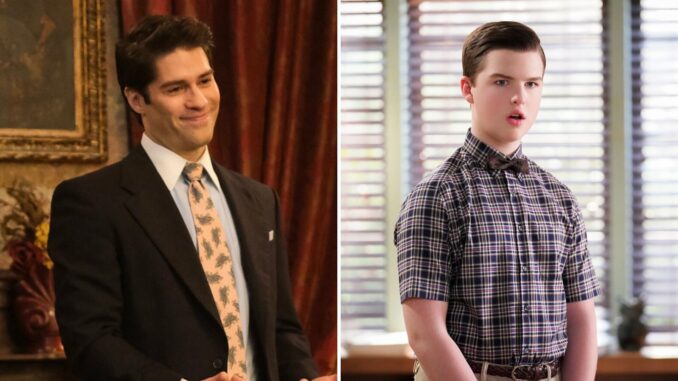
When Spectral Meets Skeptical: Are Ghosts and Young Sheldon Headed for a Crossover?
The air crackles with an almost palpable buzz, a delicious paradox born in the antechambers of fan imagination and fueled by the gleeful pronouncements of their respective stars. Are Ghosts and Young Sheldon, two titans of CBS’s Thursday night lineup, truly headed for a crossover? The very notion sends a delightful shiver down the spine, a clash of cosmic proportions that pits the spectral against the scientific, the eternally past against the precociously present. It’s an idea so gloriously absurd, so inherently challenging, that it speaks to the boundless creativity of television and the unyielding hope of viewers to see their favorite worlds collide.
At first glance, the two series couldn't be more diametrically opposed. On one side, we have Ghosts, a whimsical, heartfelt, and uproariously funny ensemble comedy about a young couple, Sam and Jay, who inherit a dilapidated country estate populated by the spectral remains of its former inhabitants. These "livings" and "dead" navigate the complexities of their cohabitation with a blend of anachronistic humor, profound emotional arcs, and genuine affection. It’s a show where the rules of the afterlife are as pliable as a Victorian corset, where a Viking warrior, a 60s flower child, a Jazz Age flapper, and a fast-talking finance bro from the 90s coexist, bound by the confines of Woodstone Mansion and their inability to "move on." The very premise demands a suspension of disbelief, an embrace of the ethereal and the unexplained.
Then there is Young Sheldon. Set in the late 1980s and early 90s in East Texas, it’s a meticulously crafted origin story for one of television's most iconic characters, Sheldon Cooper. The show thrives on a different kind of magic: the magic of a gifted mind grappling with the mundane, the hilarity born from a boy genius applying rigorous logic to the illogical world around him. Its humor springs from family dynamics, the clash between intellect and intuition, and Sheldon’s steadfast adherence to scientific principles. Ghosts, spirits, or any form of supernatural phenomena would, to Sheldon, be an affront to reason, a problem to be solved with equations or dismissed as a symptom of indigestion. His world is governed by physics, mathematics, and the periodic table, not by the whispers of the departed.
This stark contrast, however, is precisely where the tantalizing potential of a crossover lies. Imagine the glorious friction! Picture Sheldon Cooper, perhaps on a family road trip that, through some sitcom contrivance, leads the Coopers to the quaint, yet undeniably haunted, Woodstone B&B. His initial reaction would be priceless: a rapid-fire barrage of scientific debunking, an urgent need to categorize and rationalize what his senses are perceiving. "Mother, that man appears to have an arrow protruding from his chest, yet he exhibits no signs of arterial bleeding. Is this some form of crude, yet elaborate, prank?" he might inquire, utterly perplexed by the sight of Pete Martino.
The ghosts, in turn, would be equally flummoxed by the diminutive genius. Pete, the eternally optimistic scout leader, might try to teach Sheldon knot-tying, only to be met with a lecture on the tensile strength of various materials. Isaac, the Revolutionary War officer, would likely try to impress him with tales of strategic prowess, only for Sheldon to point out historical inaccuracies. Trevor, the pants-less finance bro, might attempt to "bro out," while Flower, with her perpetually hazy demeanor, might try to offer him a mystical insight he’d instantly dismiss. And Hetty, the Victorian matriarch, would undoubtedly find his posture appalling and his casual attire scandalous.
The Coopers themselves would offer a rich tapestry of reactions. Mary, deeply religious, might see the ghosts as either lost souls in need of prayer or, perhaps, even demonic entities to be exorcised. George Sr., ever the pragmatic everyman, would likely assume it's an elaborate tourist trap or a scam. Missy, with her sharp wit and open mind, might be the only one truly entertained, finding the spectral residents more interesting than her brother. And Meemaw, ever the wild card, might simply see it as an opportunity for a good story, or perhaps a chance to win at cards against the spirits.
A crossover, if it were to transcend a mere easter egg or a fleeting dream sequence, would require a narrative tightrope walk of epic proportions. Would Sam’s ability to see and hear the ghosts somehow extend to Sheldon, challenging his very understanding of the universe? Or would Sheldon, through sheer scientific determination, invent a device that makes the ghosts temporarily corporeal, leading to a physical comedy of errors? The possibilities, however improbable, spark the imagination precisely because they force us to reconsider the boundaries of both shows.
Ultimately, the excitement shared by the stars of Ghosts and Young Sheldon isn't just about a logistical possibility; it's about the joyous spirit of creative play. It’s a testament to the fact that even in the structured world of network television, there’s a yearning for the wonderfully unexpected. While a full-fledged, canon-altering crossover might remain a delightful pipe dream, the very notion of Sheldon Cooper trying to rationalize a headless Hessian or Hetty Woodstone attempting to instill proper decorum in a child who dismisses "sensory overload" is a testament to the power of television to spark our imaginations. It reminds us that sometimes, the most captivating stories aren't just about what is, but about the thrilling, improbable "what if." And in a world where a genius boy and a house full of friendly specters can share a network, perhaps even a universe, anything is possible.
